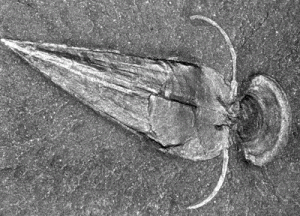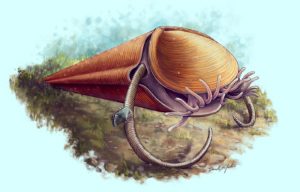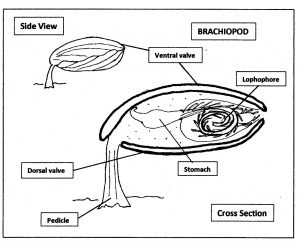Just this week an article has been published in the scientific journal Nature that clears up a problem that has plagued paleontologists for over 175 years. The paper by Joseph Moysiuk and Jean Bernard Caron of the University of Toronto along with Martin R. Smith of Cambridge University examined over 1500 specimens of Hyoliths, a rather common Paleozoic marine fossil whose shell resembles an ice cream cone with a lid on top and a spine coming out each side, see picture below.

Because only the hard parts of extinct animals are usually preserved the exact kind of animal that lived inside the Hyolith shell remained a mystery. The most common guess was that Hyoliths were a mollusk, that they were either a snail or clam of some kind. However, using specimens from the famous Burgess Shale formation in British Columbia Professor Moysiuk et al succeeded in finding enough of the soft tissue of Hyoliths to be able to determine their feeding mechanism and it turns out that Hyoliths are not mollusks at all but instead are related to Brachiopods, a ancient and very common type of fossil but a phylum which today contains only a few rare species. See the picture below for a reconstruction of a Hyolith.

Compare this to a modern Brachiopod.

Whereas Brachiopods attach themselves to the sea bottom by means of a fleshy “pedicle” the Hyoliths seem to have pushed their conic shell into the sand and raised themselves up on their two spines. Because of this difference the scientists maintain that Hyoliths are related to the Brachiopods within a larger group called Lophophorates instead of being a Brachiopod.
The small tentacles reaching out of the Hyolith is the lophophore, the feeding structure common between the Hyoliths and Brachiopods and which gives the larger group its name. If you’d like to read an article in Sci-News about the work of Professor Moysiuk et al click on the link below.
http://www.sci-news.com/paleontology/hyoliths-cambrian-lophophorates-04531.html
I have two specimens of Hyoliths in my fossil collection, along with thousands of Brachiopods so this discovery by Professor Moysiuk et al is of particular interest to me. Like Dinosaurs and Trilobites I think that the more we learn about the animals that once lived on this Earth the more fascinating they become.
Maybe one day I’ll get to do a post on Nidulites, a rarer and more mysterious Paleozoic marine fossil of which I have about a dozen specimens. Till then.
